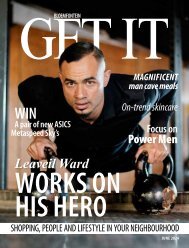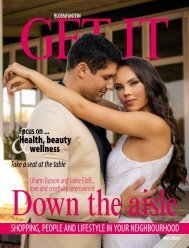You also want an ePaper? Increase the reach of your titles
YUMPU automatically turns print PDFs into web optimized ePapers that Google loves.
your baby or toddler safe on car journeys. In SA the law states that it<br />
is illegal for an infant (a child under 3 years) to travel without being<br />
strapped into a suitable car seat – and crash tests show that children<br />
under 1.5m are much safer in car seats or boosters. Children strapped in<br />
with seatbelts before they are tall enough to achieve a good fit for the<br />
seatbelt, were found to be three times more likely to be injured in a crash<br />
than adults. Ensure you get the correct car seat for your child’s age and<br />
weight and install it correctly (see tips below).<br />
Never leave children alone in a car<br />
Even if you’re only stepping out of the car for a few minutes, you should<br />
never leave a child unattended in a car. A variety of dangers can occur,<br />
including a child fiddling with controls causing the car to move. On a<br />
hot day, the temperature inside a car can also get to dangerously high<br />
levels and cause serious harm or even death. Children are particularly<br />
susceptible to overheating and dehydration, and inside a hot car, a<br />
toddler’s body temperature can rise three to five times as quickly as that<br />
of an adult, which can lead directly to heatstroke and death.<br />
Be prepared in the event of a hijacking<br />
Hijackings unfortunately remain a reality and anyone who drives a car<br />
needs to be aware and cautions. Being a victim of hijacking while you<br />
are alone in your vehicle is traumatic enough – but having your children<br />
with you is even more so. Never leave your children in the car alone,<br />
especially if you must get out to open a gate. It is advised that they<br />
exit the vehicle with you, so that you are all separated from the vehicle<br />
should an attack occur. Also, when travelling with your children, The<br />
National Hijack Prevention Academy recommends that the youngest<br />
child should be seated behind the driver and the oldest to the left. If you<br />
are hijacked and need to get out of the car, you can move quickly from<br />
the driver’s door to the door directly behind it. You can reach across the<br />
youngest child to unstrap the older child. The eldest child can cling to<br />
you as you remove them both together. Take the key with you. You need<br />
the key as a ‘negotiating tool’ – the perpetrators want your vehicle, and<br />
you want your children. If you have a central locking system, remember<br />
to open all doors before getting out of the car and handing the keys<br />
over to the hijacker. This will allow you to open your rear passenger doors<br />
and get your children out while the hijacker is getting into the driving<br />
seat. Remain as calm as possible and follow the hijacker’s instructions<br />
interacting with them only to make clear what movements you are<br />
about to make.<br />
Don’t be tempted to text<br />
We all know the temptation to check our cell phones when we hear a<br />
notification – but reading and responding to messages while driving is a<br />
huge no-no. Put your phone on silent while driving. The risk that you put<br />
yourself, your passengers and other road users in by being distracted by<br />
your phone is not worth it.<br />
Activate child safety locks<br />
To prevent children from opening the doors while the car is moving,<br />
activate the child safety locks on your car doors. These locks are usually<br />
found on the inside of the car doors. You should also lock the power<br />
windows to prevent your children from getting injured. Children can<br />
unintentionally trigger a power window, trapping hands, fingers, arms<br />
or even their head. At the push of a button, the driver can make the car<br />
much safer for children by having complete control over power windows.<br />
Tips for using child car seats:<br />
1. Always use a car seat, even on short<br />
trips. It’s obvious, and it’s the law, but we<br />
still sometimes see children travelling<br />
without a car seat. Accidents can happen,<br />
even on the shortest trips. Many children<br />
are taken on trips of less than 3km without<br />
being strapped in, therefore, if unrestrained,<br />
an impact can prove fatal from speeds of<br />
20km/h. In the event of an accident when a<br />
child is not restrained by a safety device, the<br />
risk of being ejected from the car is 6 or 7<br />
times greater.<br />
2. Avoid second-hand car seats. You can<br />
never be sure a second-hand car seat is<br />
a safe car seat. You don’t know if it’s been<br />
damaged in an accident, or has pieces<br />
missing or has been misused in any way.<br />
3. Use the correct size car seat. It’s best to<br />
buy a car seat for your child based on their<br />
current height and weight. Investigate and<br />
consider all your options when purchasing<br />
a seat that claims to cover multiple age<br />
groups.<br />
4. Install car seats correctly. Car seats for<br />
babies under 1 year or 80 cm in height must<br />
always be rear facing; If your car has ISOFIX<br />
Points, you can select any car seat with<br />
either an ISOFIX connection or opt for a seat<br />
that uses your car’s seat belt. ISOFIX Systems<br />
provides increased safety by eliminating<br />
human error when the seat is installed in<br />
the car; If you don’t have ISOFIX you can<br />
use a seat belt installed car seat.; Pull the car<br />
seat’s safety harness tight. If you can just slip<br />
one finger between the harness and your<br />
child’s chest, it’s tight enough.<br />
5. Take your child’s coat off. A thick coat can<br />
make the harness less effective. If your child<br />
is cold, use their coat as a blanket over the<br />
harness.<br />
6. Make sure the safety harness is at the<br />
right height and not twisted. The harness<br />
should always be adjusted to the correct<br />
height setting which is at shoulder height.<br />
Check there are no twists in the straps.<br />
7. Beware of activated frontal airbags.<br />
The safest place for a rear-facing car seat<br />
is on the back seat. This avoids the danger<br />
of front airbags inflating against the seat.<br />
Deactivate the front airbag if you use your<br />
car seat on the front passenger seat and<br />
place this seat in the further most position.<br />
8. Keep loose items off the rear parcel<br />
shelf. In an accident, even small loose items<br />
can turn into dangerous projectiles. Tuck<br />
them away safely. Information supplied by<br />
Child Passenger Safety<br />
<strong>Mar</strong>ch 20<strong>21</strong> Get It • <strong>Ballito</strong> <strong>Umhl</strong>anga 39


















